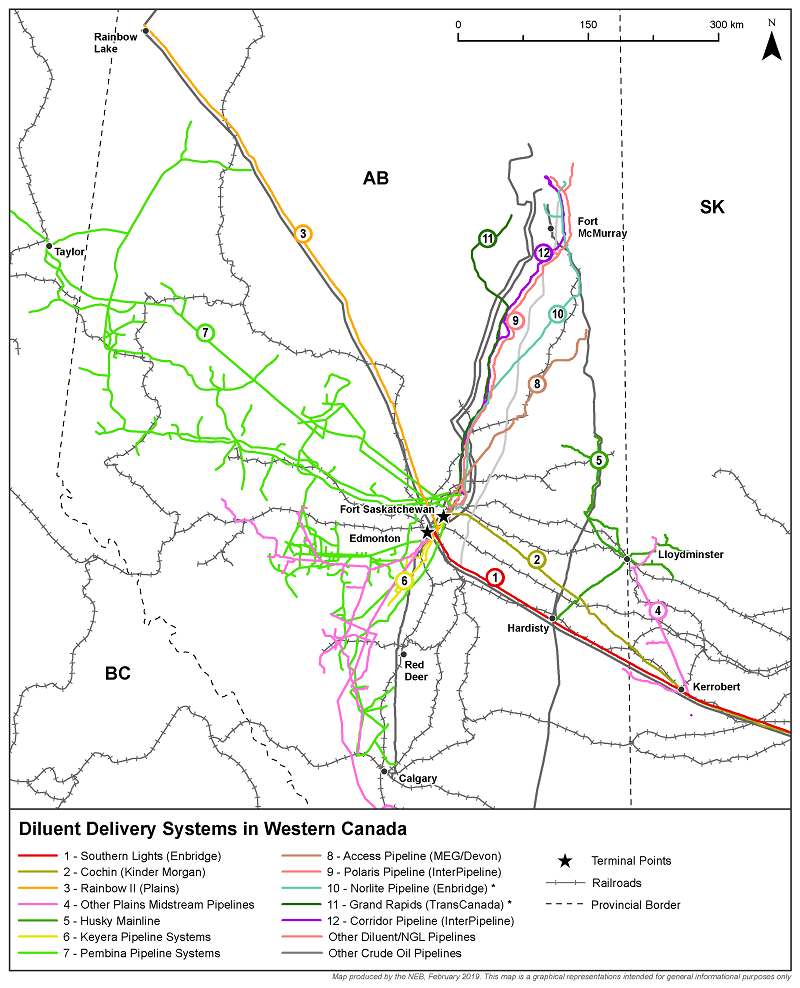Market Snapshot: Production of condensate and pentanes plus reached an all-time high in western Canada in 2018
Release date: 2019-02-06
Condensate and pentanes plus are two important sources of diluent for Canada’s oil sands. In August 2018, production of condensate and pentanes plus in western Canada reached an all-time high of 414 thousand barrels per day (Mb/d); 35% higher than August of the previous year. Production in September fell to 401 Mb/d, 1.5% below August (Figure 1). Condensate and pentanes plus production averaged 379 Mb/d during the first 9 months of 2018, with Alberta producing 83%, British Columbia producing almost 17%, and Saskatchewan producing less than 1%.
Figure 1: Western Canadian diluent production
Source and Description
Source: Alberta Energy Regulator, BC Ministry of Energy, Mines and Petroleum Resources, Saskatchewan Ministry of the Economy - Petroleum and Natural Gas Division
Description: The chart above shows the historical production of pentanes plus and condensate in western Canada by province as well as the share of pentanes plus out of total historical condensate and pentanes plus production from January 2010 to September 2018. Pentane plus and condensate production in August 2018 reached an all-time high of 414 Mb/d, 35% over 2017. The average annual share of pentanes plus on total diluent production fell from 88% in 2010 to 87% in 2012, and to 67% in 2018.
In its raw form, bitumen produced by the Canadian oil sands is thick like peanut butter. Therefore, bitumen must be diluted with a much lighter hydrocarbon so it will flow in pipelines. Oil sands “diluent” is a mix of thin oils that have a variety of names.Footnote 1 The most commonly used light oils in the diluent mix are condensate, pentanes plus, and naphtha.Footnote 2
Pentanes plus has been the largest contributor to western Canadian diluent production. However, since 2013, condensate production has been growing faster than pentanes plus production. This is because of growing condensate production from unconventional, liquids-rich gas wells in the Montney and Duvernay formations in Alberta and British Columbia. The share of pentanes plus production dropped from 87% in 2012 to 67% in 2018, and is expected to further decrease as future condensate production is expected to increase quickly.
In western Canada, pentanes plus and condensate production comes from gas processing units (gas plants), fractionators and other facilities scattered throughout Alberta, British Columbia, and Saskatchewan. Supply is transported by pipelines (including Peace, Rainbow, and Keyera) to the main oil sands diluent hub in Edmonton/Fort Saskatchewan (Figure 2). Fort Saskatchewan also receives diluent imports from the United States on the Cochin and Southern Lights pipelines, as well as by rail. From Fort Saskatchewan, several diluent pipelines owned by Enbridge, Inter Pipeline, and other companies transport diluent to oil sands producing regions.
Figure 2: Western Canadian oil sands diluent infrastructure
Source and Description
Source: NEB, company websites
Description: The map above shows major oil pipelines in western Canada that carry diluent. Many of the pipelines gather pentanes plus, condensate, crude oil, and other natural gas liquids (NGL) from producing areas to the main oil and NGL hub at Edmonton/Fort Saskatchewan. Other pipelines connect the hub to oil production sites in northern and central Alberta, delivering diluent north to oil sands facilities and transporting crude oil production south. From Edmonton/Fort Saskatchewan, major export pipelines move crude oil west, east, and south to oil consumption sites in the United States and Canada. In general, diluent pipelines flow in the opposite direction of nearby crude oil pipelines.
- Date modified:

